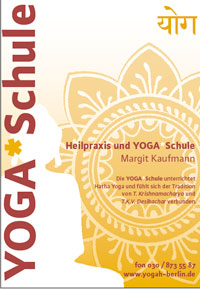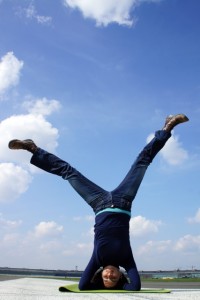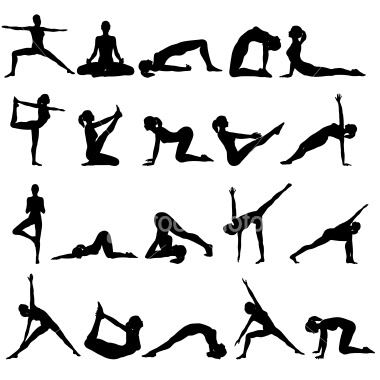 Many people wonder, “Why should I do yoga?” And while this is an individual question, I think it’s important to understand what the point of the practice is before deciding to make it a part of your life.
Many people wonder, “Why should I do yoga?” And while this is an individual question, I think it’s important to understand what the point of the practice is before deciding to make it a part of your life.
In my last blog about Hatha yoga in Berlin, I talked a bit about the current “trendy nature” of yoga and why there seem to be so many yoga styles on offer. But the true goal of Yoga is to bring the practitioner into a state of perfect peace with themself and with the world. This cannot be achieved overnight. And so, to approach this goal, one spends a lifetime practicing this discipline. Although perfect peace is the most difficult state to attain, it is said that everyone can approach it through a sincere practice of yoga.
As mentioned in my previous blog, originally there were four different types of yoga created. These different types were created so that people were able to practice the kind of yoga that best fits them as an individual. The four original yogas are: Njana Yoga, Karma Yoga, Bhakti Yoga and Raja Yoga.
The Njana yoga practitioners use the intellect to attain a state of inner peace. Their whole practice is about analyzing the world around them, and distinguishing what is real from illusion. This yoga is the best kind for people who have a need to intellectualize everything about the world.
The Karma Yoga practitioners strive to attain the inner peace state through action (Karma being the Sanskrit word for “action” or “to do”). Their practice is based on taking positive action without being attached to the fruits of one’s deeds. This kind of yoga is best for those who need to live an active life and keep themselves constantly busy.

The Bhakti Yoga practitioners use their emotions in order to attain their yogic goal. Bhakti is the yoga of devotion. This kind of yoga is said to be the best for people who are of an emotional nature and need to sublimate their emotions in order to attain inner peace. This yoga would concentrate on rituals, symbols, chanting. It is said that by doing so the practitioners channel their emotions to a higher state of being.
Raja yoga practitioners try to attain peace through meditation. But in order to sit down and meditate one must not only learn how to control the mental fluctuations but also to have a fit body that can manage to sit motionless with no pain for an hour. To be able to do the latter Hatha Yoga was created. This is the only type of yoga from the original ones that focuses on the physical body. I teach this kind of yoga because it addresses the body, mind and energy levels of the practitioner throughout his/her self-exploration towards inner peace.
 English Yoga Berlin is very excited to be offering this new English yoga class on the beautiful hill of Berlin “Schöneberg”. Starting on September 17th, we will be teaching at the center of Yogah-Berlin located at Motzstrasse 64, 10777 Berlin-Schöneberg.
English Yoga Berlin is very excited to be offering this new English yoga class on the beautiful hill of Berlin “Schöneberg”. Starting on September 17th, we will be teaching at the center of Yogah-Berlin located at Motzstrasse 64, 10777 Berlin-Schöneberg.










 Today it is very common to hear about many different kinds of yoga in Berlin. And with so many variations to choose from, it can get rather confusing. In truth, there were originally only 4 types of yoga: Njana Yoga, Karma Yoga, Bhakti Yoga and Raja Yoga. These yogas were created so that people could practice the kind of yoga that was most attune to their own character.
Today it is very common to hear about many different kinds of yoga in Berlin. And with so many variations to choose from, it can get rather confusing. In truth, there were originally only 4 types of yoga: Njana Yoga, Karma Yoga, Bhakti Yoga and Raja Yoga. These yogas were created so that people could practice the kind of yoga that was most attune to their own character.

 a Yoga in Berlin, I often use Sanskrit words in our classes when wanting to describe a pose or the reason behind something we are supposed to do. I try to always accompany these words with a translation, but every now and then I still see confused faces looking up at me. I realize that sometimes, especially when teaching yoga in English, it is important to not only describe the action in Sanskrit but to also offer a translation in plain English.
a Yoga in Berlin, I often use Sanskrit words in our classes when wanting to describe a pose or the reason behind something we are supposed to do. I try to always accompany these words with a translation, but every now and then I still see confused faces looking up at me. I realize that sometimes, especially when teaching yoga in English, it is important to not only describe the action in Sanskrit but to also offer a translation in plain English. spects of the self: the body, the mind and the soul. Over the centuries, it has become common for people to also translate the word yoga as “union”. And since the practice of Yoga affects people in so many different ways, the definitions of Yoga seem to be multiplying as yoga spreads throughout the world.
spects of the self: the body, the mind and the soul. Over the centuries, it has become common for people to also translate the word yoga as “union”. And since the practice of Yoga affects people in so many different ways, the definitions of Yoga seem to be multiplying as yoga spreads throughout the world.
